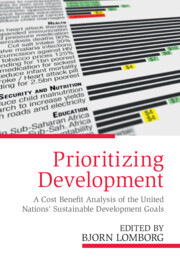 Prioritizing Development
Prioritizing Development Published online by Cambridge University Press: 30 May 2018
Introduction
Economists have long recognized the positive association between population health and income per capita. Traditionally, this association was viewed as reflective of a causal link from income to health. In recent years, robust evidence has been offered in support of the view that the association also reflects a reverse causal link from population health to income. However, this growing body of research has yet to identify the specific and essential role of women's health as a driver of economic growth. We believe that there are strong reasons to believe that female-specific health interventions are a sound investment for promoting economic well-being at both individual and population levels. In particular, we focus on vaccination against human papilloma virus (HPV), largely motivated by the substantial cervical cancer burden borne by women in resource-poor countries during what is often the most productive years of their lives.
Background
Cervical Cancer in a Global Context
Globally, cervical cancer is the fourth most common cancer among women, with more than a half-million cases diagnosed and more than 200,000 deaths reported every year. The burden of cervical cancer is disproportionately high in the developing world: about 85 percent of cases occur in less-developed countries, where the disease represents the second-deadliest cancer among women (following breast cancer) (Ferlay et al., 2013). The impact of the disease is further accentuated by the young average age at death, often when women are most likely to be bearing children, raising and supporting families, and participating in the workforce (Arbyn et al., 2011). For these reasons, cervical cancer conveys potentially large negative familial and societal externalities, particularly detrimental to children of affected women.
In developed countries, adequate health system infrastructure, resources, and personnel have reduced the cervical cancer burden substantially, but fundamental challenges remain in developing countries (Gakidou, Nordhagen and Obermeyer, 2008).Virtually all cervical cancer cases are related to HPV infection, a sexually transmitted virus that can cause different types of cancer in both women and men (World Health Organization, 2007). It should be emphasized that the majority of women with HPV do not develop cervical cancer; rather, women become susceptible to developing cervical cancer following HPV infection, and other environmental factors are required for the cancer to develop.
To save this book to your Kindle, first ensure [email protected] is added to your Approved Personal Document E-mail List under your Personal Document Settings on the Manage Your Content and Devices page of your Amazon account. Then enter the ‘name’ part of your Kindle email address below. Find out more about saving to your Kindle.
Note you can select to save to either the @free.kindle.com or @kindle.com variations. ‘@free.kindle.com’ emails are free but can only be saved to your device when it is connected to wi-fi. ‘@kindle.com’ emails can be delivered even when you are not connected to wi-fi, but note that service fees apply.
Find out more about the Kindle Personal Document Service.
To save content items to your account, please confirm that you agree to abide by our usage policies. If this is the first time you use this feature, you will be asked to authorise Cambridge Core to connect with your account. Find out more about saving content to Dropbox.
To save content items to your account, please confirm that you agree to abide by our usage policies. If this is the first time you use this feature, you will be asked to authorise Cambridge Core to connect with your account. Find out more about saving content to Google Drive.